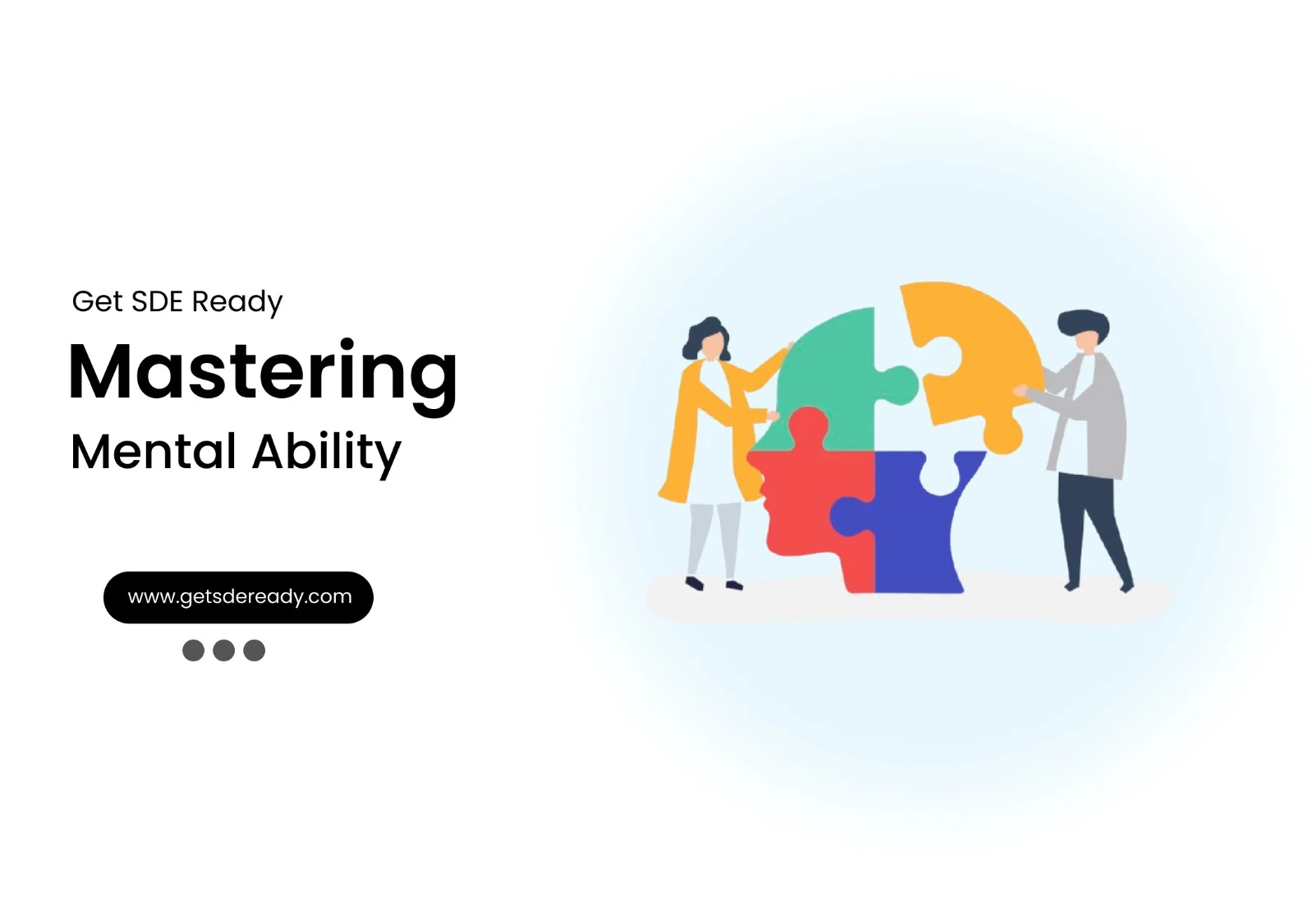Data Structures and Algorithms
- Introduction to Data Structures and Algorithms
- Time and Space Complexity Analysis
- Big-O, Big-Theta, and Big-Omega Notations
- Recursion and Backtracking
- Divide and Conquer Algorithm
- Dynamic Programming: Memoization vs. Tabulation
- Greedy Algorithms and Their Use Cases
- Understanding Arrays: Types and Operations
- Linear Search vs. Binary Search
- Sorting Algorithms: Bubble, Insertion, Selection, and Merge Sort
- QuickSort: Explanation and Implementation
- Heap Sort and Its Applications
- Counting Sort, Radix Sort, and Bucket Sort
- Hashing Techniques: Hash Tables and Collisions
- Open Addressing vs. Separate Chaining in Hashing
- DSA Questions for Beginners
- Advanced DSA Questions for Competitive Programming
- Top 10 DSA Questions to Crack Your Next Coding Test
- Top 50 DSA Questions Every Programmer Should Practice
- Top Atlassian DSA Interview Questions
- Top Amazon DSA Interview Questions
- Top Microsoft DSA Interview Questions
- Top Meta (Facebook) DSA Interview Questions
- Netflix DSA Interview Questions and Preparation Guide
- Top 20 DSA Interview Questions You Need to Know
- Top Uber DSA Interview Questions and Solutions
- Google DSA Interview Questions and How to Prepare
- Airbnb DSA Interview Questions and How to Solve Them
- Mobile App DSA Interview Questions and Solutions
DSA Interview Questions
- DSA Questions for Beginners
- Advanced DSA Questions for Competitive Programming
- Top 10 DSA Questions to Crack Your Next Coding Test
- Top 50 DSA Questions Every Programmer Should Practice
- Top Atlassian DSA Interview Questions
- Top Amazon DSA Interview Questions
- Top Microsoft DSA Interview Questions
- Top Meta (Facebook) DSA Interview Questions
- Netflix DSA Interview Questions and Preparation Guide
- Top 20 DSA Interview Questions You Need to Know
- Top Uber DSA Interview Questions and Solutions
- Google DSA Interview Questions and How to Prepare
- Airbnb DSA Interview Questions and How to Solve Them
- Mobile App DSA Interview Questions and Solutions
Data Structures and Algorithms
- Introduction to Data Structures and Algorithms
- Time and Space Complexity Analysis
- Big-O, Big-Theta, and Big-Omega Notations
- Recursion and Backtracking
- Divide and Conquer Algorithm
- Dynamic Programming: Memoization vs. Tabulation
- Greedy Algorithms and Their Use Cases
- Understanding Arrays: Types and Operations
- Linear Search vs. Binary Search
- Sorting Algorithms: Bubble, Insertion, Selection, and Merge Sort
- QuickSort: Explanation and Implementation
- Heap Sort and Its Applications
- Counting Sort, Radix Sort, and Bucket Sort
- Hashing Techniques: Hash Tables and Collisions
- Open Addressing vs. Separate Chaining in Hashing
- DSA Questions for Beginners
- Advanced DSA Questions for Competitive Programming
- Top 10 DSA Questions to Crack Your Next Coding Test
- Top 50 DSA Questions Every Programmer Should Practice
- Top Atlassian DSA Interview Questions
- Top Amazon DSA Interview Questions
- Top Microsoft DSA Interview Questions
- Top Meta (Facebook) DSA Interview Questions
- Netflix DSA Interview Questions and Preparation Guide
- Top 20 DSA Interview Questions You Need to Know
- Top Uber DSA Interview Questions and Solutions
- Google DSA Interview Questions and How to Prepare
- Airbnb DSA Interview Questions and How to Solve Them
- Mobile App DSA Interview Questions and Solutions
DSA Interview Questions
- DSA Questions for Beginners
- Advanced DSA Questions for Competitive Programming
- Top 10 DSA Questions to Crack Your Next Coding Test
- Top 50 DSA Questions Every Programmer Should Practice
- Top Atlassian DSA Interview Questions
- Top Amazon DSA Interview Questions
- Top Microsoft DSA Interview Questions
- Top Meta (Facebook) DSA Interview Questions
- Netflix DSA Interview Questions and Preparation Guide
- Top 20 DSA Interview Questions You Need to Know
- Top Uber DSA Interview Questions and Solutions
- Google DSA Interview Questions and How to Prepare
- Airbnb DSA Interview Questions and How to Solve Them
- Mobile App DSA Interview Questions and Solutions
Roadmap to Learn MERN Stack from Scratch in 2025
Are you ready to dive into the world of full-stack web development with the MERN stack? In 2025, the MERN stack remains one of the most sought-after technology stacks for building modern, scalable web applications. Whether you’re a beginner or looking to enhance your skills, this comprehensive roadmap will guide you through learning MongoDB, Express.js, React.js, and Node.js from scratch. To accelerate your journey, sign up for free courses or get the latest updates on our offerings by clicking here. Let’s get started!
Introduction to MERN Stack
The MERN stack is a powerful full-stack JavaScript framework comprising four key technologies:
- MongoDB: A NoSQL database that stores data in flexible, JSON-like documents, ideal for handling large datasets.
- Express.js: A lightweight Node.js framework for building robust APIs and server-side applications.
- React.js: A JavaScript library for creating dynamic, component-based user interfaces with a virtual DOM for performance.
- Node.js: A runtime environment that allows JavaScript to run on the server, enabling asynchronous, event-driven applications.
Why Choose MERN Stack in 2025?
The MERN stack’s popularity stems from its use of JavaScript across the entire development stack, reducing the need to learn multiple languages. In 2025, it’s widely adopted by startups and tech giants like Google and Amazon due to its scalability and rich ecosystem. According to industry trends, the demand for full-stack developers proficient in MERN is expected to grow, with salaries in the U.S. ranging from $90,000 to $120,000 annually, depending on experience and location.
Benefits of Learning MERN
- Single Language: JavaScript unifies front-end and back-end development.
- Scalability: Build applications that handle high traffic efficiently.
- Community Support: Access a wealth of tutorials, libraries, and forums.
Career Growth: High demand for MERN developers in diverse industries.
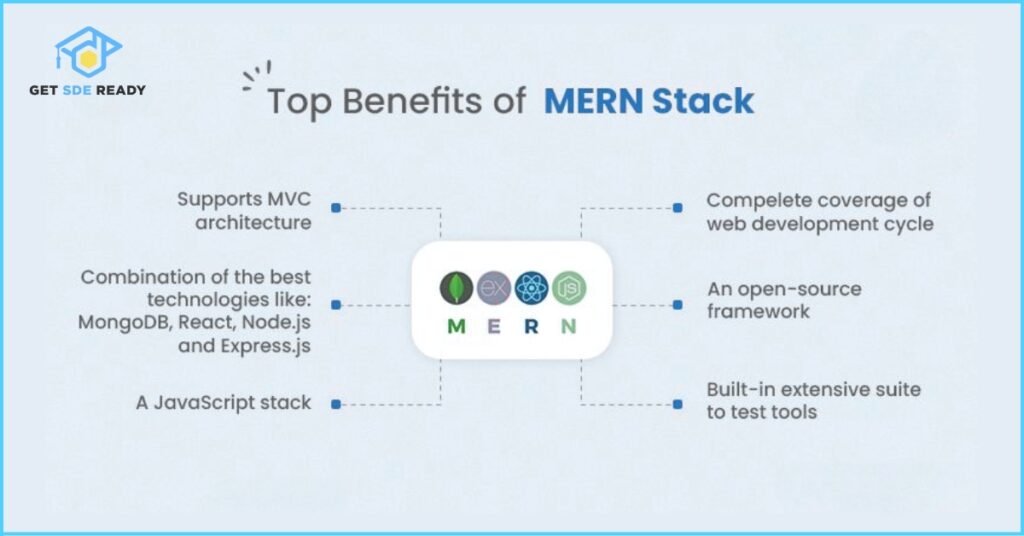
Prerequisites
Before diving into the MERN stack, you’ll need a foundational understanding of web development:
- HTML: Learn tags, attributes, semantic HTML, and forms to structure web pages.
- CSS: Master styling, layouts (flexbox, grid), and responsive design principles.
- JavaScript: Understand variables, functions, arrays, objects, DOM manipulation, and asynchronous programming (promises, async/await).
- Git and GitHub: Familiarize yourself with version control for collaboration and code management.
If you’re new to these, start with beginner-friendly resources like this web development course to build a strong foundation.
Learning HTML, CSS, and JavaScript
A solid grasp of HTML, CSS, and JavaScript is essential for MERN stack development. Here’s a breakdown of what to focus on:
HTML
- Key Concepts: Tags, attributes, semantic HTML, forms, tables, and accessibility.
- Practice: Create static web pages with headings, paragraphs, lists, and forms.
- Resources:
CSS
- Key Concepts: Selectors, properties, box model, flexbox, grid, animations, and responsive design.
- Practice: Style web pages with layouts, typography, and media queries.
- Resources:
JavaScript
- Key Concepts: Variables, data types, functions, objects, arrays, DOM manipulation, event handling, promises, and async/await.
- Practice: Build interactive features like form validation or dynamic content updates.
- Resources:
Skill | Key Topics | Estimated Learning Time |
HTML | Tags, semantic HTML, forms, accessibility | 1–2 weeks |
CSS | Flexbox, grid, responsive design, animations | 2–3 weeks |
JavaScript | DOM, async/await, functions, objects | 3–4 weeks |
Diving into React.js
React.js is the front-end powerhouse of the MERN stack, known for its component-based architecture. Here’s how to learn it:
- Basics:
- Understand JSX, components, props, and state.
- Create functional components for reusable UI elements.
- Hooks:
- Learn useState for managing component state.
- Use useEffect for handling side effects like API calls.
- Explore useContext for global state management.
- Routing:
- Implement React Router for navigation and dynamic routing.
- Practice nested routes and route parameters.
- State Management:
- Use Context API for simple applications.
- Learn Redux or Zustand for complex state management.
- Advanced Topics:
- Explore memoization, higher-order components, and CSS-in-JS libraries like Material-UI or Tailwind CSS.
Projects to Build
- To-Do List App: Implement CRUD operations with state management.
- Dynamic Form: Create a form with validation and error handling.
- Single-Page Application: Build a multi-page app with React Router.
Resources
Mastering Node.js and Express.js
Node.js and Express.js handle the back-end logic and API development in the MERN stack.
- Node.js:
- Learn the event-driven, non-blocking I/O model.
- Understand modules, NPM, and server-side scripting.
- Practice creating basic servers.
- Express.js:
- Set up routes, middleware, and RESTful APIs.
- Handle HTTP requests and responses.
- Implement error handling and logging.
- Advanced Express:
- Add authentication (JWT, OAuth).
- Use middleware for security (e.g., helmet.js).
- Serve static files for front-end integration.
- Node.js:
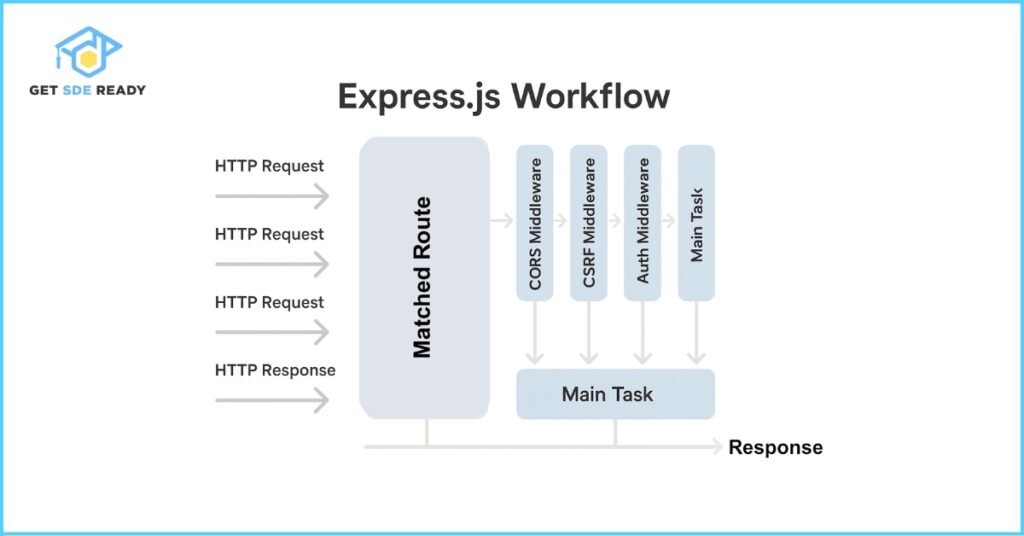
Projects to Build
- REST API for To-Do List: Create endpoints for CRUD operations.
- Authentication System: Implement JWT-based user login.
- File Upload Server: Handle file uploads with Multer.
Resources
Understanding MongoDB and Mongoose
MongoDB is a NoSQL database, and Mongoose simplifies its integration with Node.js.
- MongoDB Basics:
- Understand NoSQL databases and JSON-like documents.
- Learn CRUD operations (Create, Read, Update, Delete).
- Practice querying and indexing for performance.
- Mongoose:
- Define schemas and models for structured data.
- Use validation and middleware for data integrity.
- Connect MongoDB to Express.js applications.
- Advanced Topics:
- Use aggregation pipelines for complex queries.
- Implement population for referencing related data.
- Optimize for large datasets.
Projects to Build
- To-Do App Database: Store tasks with MongoDB.
- User Management System: Create user schemas with Mongoose.
- E-commerce Catalog: Build a product database with categories.
Resources
Integrating the MERN Stack
Bringing all components together is where the MERN stack shines. Here’s how to integrate them:
- Project Setup:
- Create separate folders for front-end (React) and back-end (Node.js/Express).
- Initialize a React app with create-react-app or Vite.
- Set up a Node.js project with Express and MongoDB.
- Connecting Front-End and Back-End:
- Use Axios or Fetch API in React to communicate with Express APIs.
- Implement CRUD operations for seamless data flow.
- Authentication:
- Use JWT for secure user authentication.
- Protect API routes with middleware.
- Manage user sessions on the front-end.
- Deployment:
- Deploy the front-end on Vercel or Netlify.
- Host the back-end on Heroku, AWS, or DigitalOcean.
- Use environment variables for sensitive data (e.g., MongoDB URI).
Projects to Build
- Full-Stack To-Do App: Combine React, Express, and MongoDB with user authentication.
- Blog Platform: Implement post creation, editing, and commenting.
- E-commerce Site: Build product listings, cart, and checkout features.
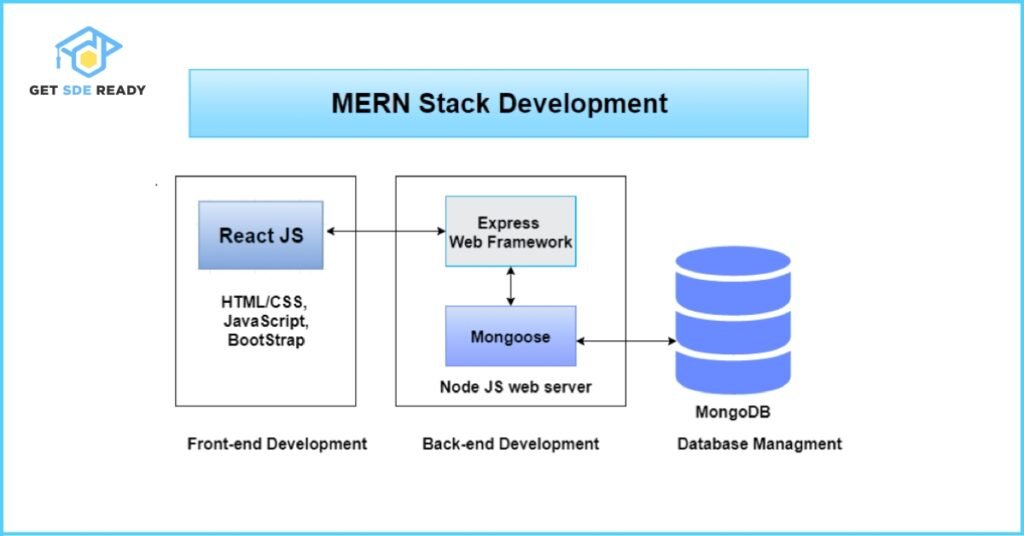
Resources
Building Real-World Projects
Hands-on projects are critical for mastering the MERN stack and building a portfolio. Here are five project ideas:
Project | Features | Technologies |
Personal Blog | User authentication, posts, comments, categories | React, Express, MongoDB |
Task Manager | CRUD tasks, due dates, priorities | React, Express, MongoDB |
E-commerce Site | Product listings, cart, user accounts, orders | React, Express, MongoDB, Stripe |
Social Media Platform | Profiles, posts, likes, comments, following | React, Express, MongoDB, WebSocket |
Fitness Tracker | Log workouts, track progress, set goals | React, Express, MongoDB |
These projects help you apply your skills and demonstrate your expertise to potential employers.
Advanced Topics and Best Practices
To become a proficient MERN stack developer, explore these advanced topics:
- Testing:
- Write unit tests with Jest or Mocha.
- Perform integration testing with Cypress.
- Test APIs with Postman or Supertest.
- Deployment and CI/CD:
- Use Docker for containerized deployments.
- Set up CI/CD pipelines with GitHub Actions or Jenkins.
- Monitor apps with tools like Sentry or New Relic.
- Performance Optimization:
- Optimize React with memoization and lazy loading.
- Use code splitting for faster load times.
- Optimize MongoDB queries with indexing.
- Security:
- Implement HTTPS and sanitize inputs to prevent XSS.
- Use helmet.js for Express security headers.
- Secure MongoDB with proper access controls.
- Scalability:
- Implement caching with Redis.
- Use load balancers for high traffic.
- Explore microservices for large applications.
Resources
Resources for Learning
To support your learning, leverage these resources:
- Online Courses:
- Tutorials and Blogs:
- Books:
- Full Stack Development with JavaScript by Camilo Torres
- React and React Native by Vipul A M
- Communities:
- Reddit MERN Stack Community
- Stack Overflow for technical questions
- Discord servers for web development
- Crash Courses:
Career Opportunities with MERN Stack
The MERN stack opens doors to various career paths in 2025:
- Job Roles:
- Full-Stack Developer
- MERN Stack Developer
- Front-End Developer (React-focused)
- Back-End Developer (Node.js/Express-focused)
- Salary Expectations:
- U.S.: $90,000–$120,000 annually
- India: ₹6–15 LPA (Lakhs Per Annum), per industry reports
- Companies Hiring:
- Tech giants (Google, Amazon, Microsoft)
- Startups and mid-sized firms
- Freelance opportunities on platforms like Upwork
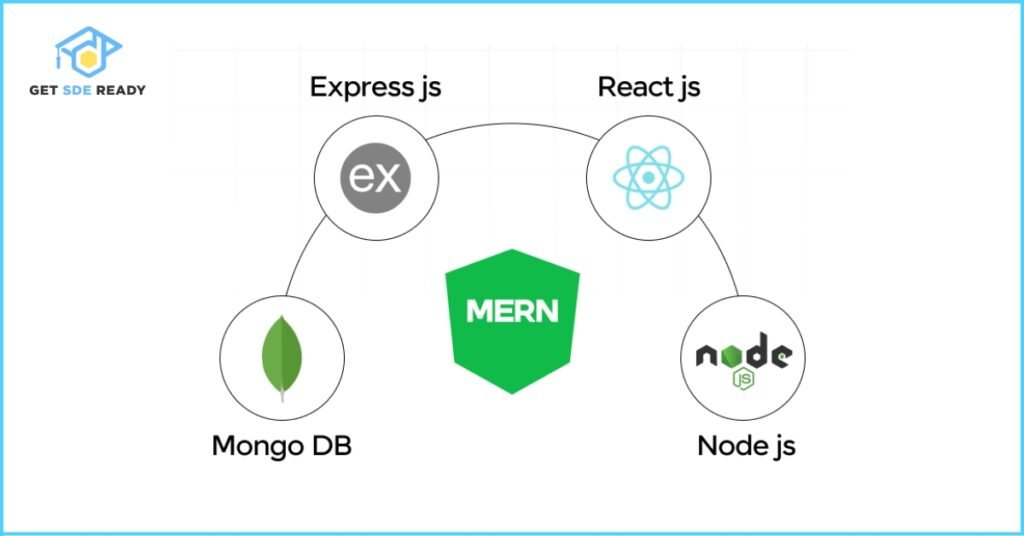
- Portfolio Building:
- Host projects on GitHub or a personal website.
- Write blogs about your projects on Medium.
- Contribute to open-source MERN projects.
- Interview Preparation:
- Practice coding on LeetCode or HackerRank.
- Study system design concepts.
- Prepare to discuss your projects in detail.
- Explore this DSA course for interview prep.
FAQs
What is the MERN stack, and why should I learn it?
The MERN stack (MongoDB, Express.js, React.js, Node.js) is a full-stack JavaScript framework for building scalable web applications. It’s popular for its efficiency and single-language approach, making it a valuable skill for career growth in web development.
Do I need prior programming experience to start with MERN stack?
No, but familiarity with HTML, CSS, and JavaScript helps. Beginners can start with these basics and progress to MERN components with structured learning.
How long does it take to learn the MERN stack?
It typically takes 3–12 months, depending on your prior experience and dedication. Consistent practice and project-building accelerate learning.
What are some good projects to build with the MERN stack?
Build a to-do app, blog platform, e-commerce site, or social media app to practice integrating front-end, back-end, and database components.
Where can I find jobs as a MERN stack developer?
Check LinkedIn, Indeed, Glassdoor, or company career pages. Tech companies and startups actively seek MERN developers for full-stack roles.
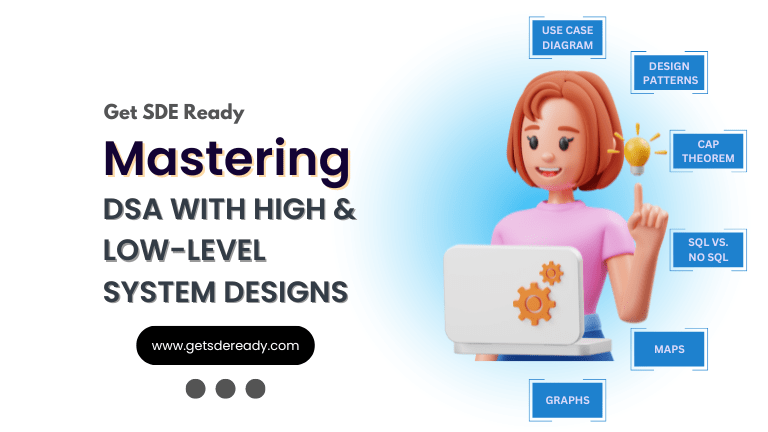
DSA, High & Low Level System Designs
- 85+ Live Classes & Recordings
- 24*7 Live Doubt Support
- 400+ DSA Practice Questions
- Comprehensive Notes
- HackerRank Tests & Quizzes
- Topic-wise Quizzes
- Case Studies
- Access to Global Peer Community
Buy for 52% OFF
₹25,000.00 ₹11,999.00
Accelerate your Path to a Product based Career
Boost your career or get hired at top product-based companies by joining our expertly crafted courses. Gain practical skills and real-world knowledge to help you succeed.

DSA, High & Low Level System Designs
- 85+ Live Classes & Recordings
- 24*7 Live Doubt Support
- 400+ DSA Practice Questions
- Comprehensive Notes
- HackerRank Tests & Quizzes
- Topic-wise Quizzes
- Case Studies
- Access to Global Peer Community
Buy for 52% OFF
₹25,000.00 ₹11,999.00
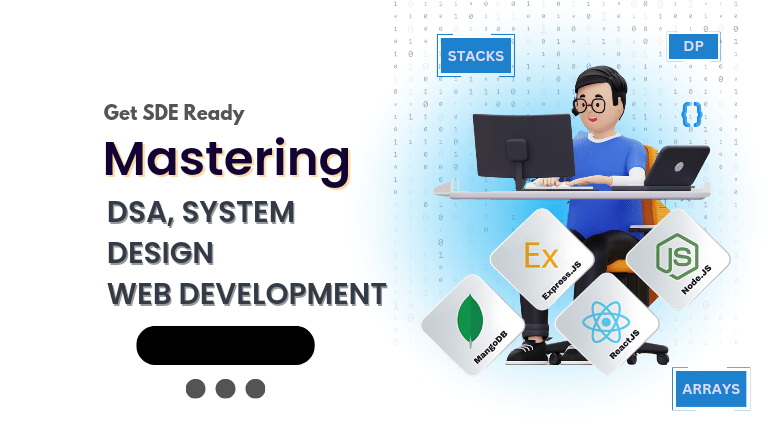
Fast-Track to Full Spectrum Software Engineering
- 120+ Live Classes & Recordings
- 24*7 Live Doubt Support
- 400+ DSA Practice Questions
- Comprehensive Notes
- HackerRank Tests & Quizzes
- 12+ live Projects & Deployments
- Case Studies
- Access to Global Peer Community
Buy for 51% OFF
₹35,000.00 ₹16,999.00
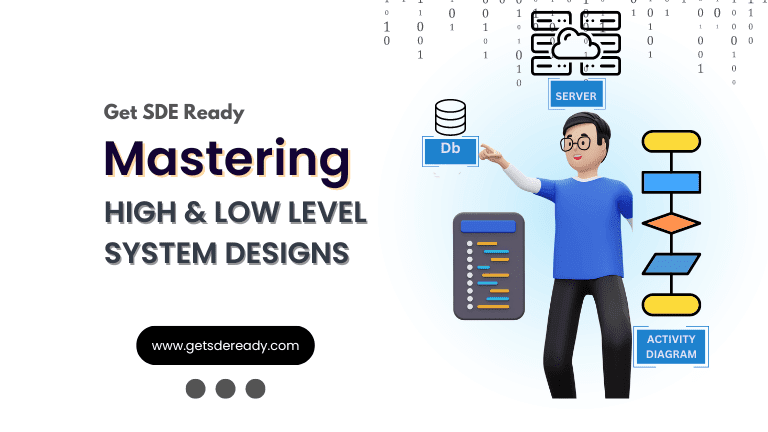
Low & High Level System Design
- 20+ Live Classes & Recordings
- 24*7 Live Doubt Support
- Case Studies
- Comprehensive Notes
- HackerRank Tests
- Topic-wise Quizzes
- Access to Global Peer Community
- Interview Prep Material
Buy for 60% OFF
₹20,000.00 ₹7,999.00
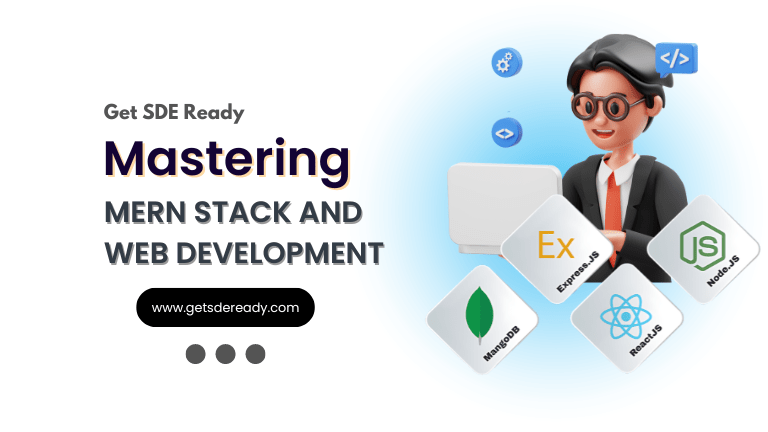
Mastering Mern Stack (WEB DEVELOPMENT)
- 65+ Live Classes & Recordings
- 24*7 Live Doubt Support
- 12+ Hands-on Live Projects & Deployments
- Comprehensive Notes & Quizzes
- Real-world Tools & Technologies
- Access to Global Peer Community
- Interview Prep Material
- Placement Assistance
Buy for 53% OFF
₹15,000.00 ₹6,999.00
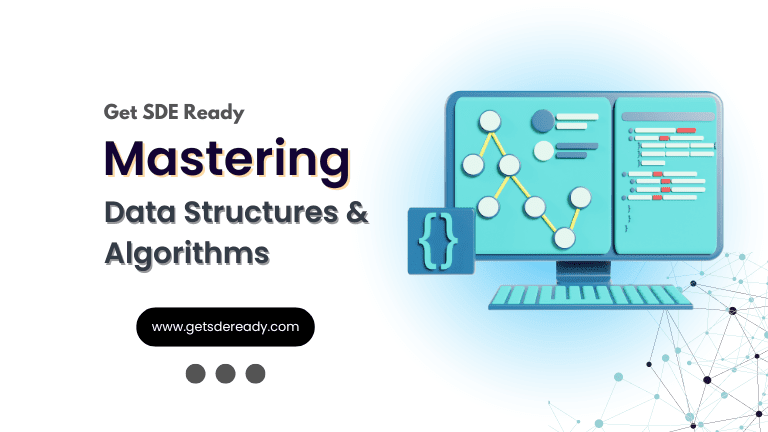
Mastering Data Structures & Algorithms
- 65+ Live Classes & Recordings
- 24*7 Live Doubt Support
- 400+ DSA Practice Questions
- Comprehensive Notes
- HackerRank Tests
- Access to Global Peer Community
- Topic-wise Quizzes
- Interview Prep Material
Buy for 40% OFF
₹9,999.00 ₹5,999.00
Reach Out Now
If you have any queries, please fill out this form. We will surely reach out to you.
Contact Email
Reach us at the following email address.
arun@getsdeready.com
Phone Number
You can reach us by phone as well.
+91-97737 28034
Our Location
Rohini, Sector-3, Delhi-110085
